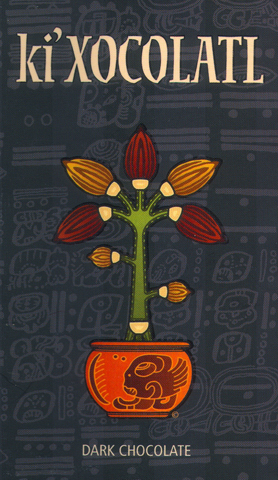Dark
by ki’Xocolatl
Impact
Shibumi (the simple/still-aesthetic of Edo Japan + a nod-out to Trevanian readers developing that hyper-awareness) as in Eureka... someone may have found ancient Criollo & very well could be among the 1st in a wave to ever so slowly lift the veil & unearth Mexican cacáo’s storied but shrouded history.
Overall dry feel contrasts to its cultivation - supposedly grown in the traditional Mayan way who so revered it in the Yucatán, where scant rainfall & poor soil make growing it nearly impossible, they developed complex silviculture, setting trees in ponds called aguadas & subterranean cenoté pools, considered real-world portals / pathways known as sacbes into the center of the Earth that pass through the “Jaws of the Underworld” -- a spirit highway via which the dead would travel in a larger saga of death & rebirth, further reinforcing cacáo’s symbolic associations with darkness, moisture, & the feminine.
This bar too posseses a cavernous flavor, very little light, just dense yet soft cocoa... the stuff of possible legends that chocolate spelunkers are in search of.
ki’Xocolatl may have struck the hallowed C-spot in a similar vein to Bonnat's Xoconuzco on the opposite coast of Mexico.
Overall dry feel contrasts to its cultivation - supposedly grown in the traditional Mayan way who so revered it in the Yucatán, where scant rainfall & poor soil make growing it nearly impossible, they developed complex silviculture, setting trees in ponds called aguadas & subterranean cenoté pools, considered real-world portals / pathways known as sacbes into the center of the Earth that pass through the “Jaws of the Underworld” -- a spirit highway via which the dead would travel in a larger saga of death & rebirth, further reinforcing cacáo’s symbolic associations with darkness, moisture, & the feminine.
This bar too posseses a cavernous flavor, very little light, just dense yet soft cocoa... the stuff of possible legends that chocolate spelunkers are in search of.
ki’Xocolatl may have struck the hallowed C-spot in a similar vein to Bonnat's Xoconuzco on the opposite coast of Mexico.
Appearance 4.1 / 5
| Color: | bi-color: brown coalface on the front; some rouge on the back |
| Surface: | scored into deep valleys separating ziggernaut mounds |
| Temper: | follows Color: flat face, greasy fudge on the flipside |
| Snap: | weak due to the molding / scoring |
Aroma 9 / 10
merry Mex: cocoa powder & coconut shell the veil over baking soda, spiced herbs (achiote, vanilla, pepper), copal resin -> ballons to ground cherry + chicle bubble gum
Mouthfeel 12 / 15
| Texture: | powdered dry & vklumped |
| Melt: | staggered but swells into corpulent almost fat body-weight to save it |
Flavor 45.2 / 50
mild cocoa redolent in vanilla -> sugar expressing itself in a cane juice spurt -> breadfruit -> faint ground cherry + chicle -> corkscrews & darkens to charred vanilla toasted over caoba wood -> drains away cocoa syrup
Quality 17.6 / 20
In a word, 'steadfast'... & about as Naked as it gets making for anti-complexity. Fools of Ivory Coast (cured reportedly for up to 8 days - a "Forastero"-type length - which seems counterindicated) except without any aggression. Even the wooden bitter insurrection (caused partially by the sweat box used in fermentation) at the mid-palate simply provides depth & minor constrast, no taste-blocking at all, & prevents the profile from being overly neutralized.
Fray Bartolomé noted in 1618 a Criollo from what today is Belize that tastes fine without any additives whatsoever. This could be a descendent of that; clearly some Criollo in its history.
It’d be revealing to a) eliminate the vanilla which covers & controls much of the contour by virtue of both the amount as well as probably being added quite late in the mix; b) increase the bean tolerance which should withstand reduced sugar content that was so readily available early on, creating a sweet beginning on the brink of cloying & raising questions whether this really contains only 27% or 28% white sugar; c) lower the heat a fraction on the roast to draw out a highlight or 2 on those fruited components; & d) shift the cocoa mass-to-fat ratio slightly.
That aside, a cacáo to nurture &, if reports hold up, revere.
ING: cocoa mass, sugar, cacáo butter, vanilla, soy lecithin; CBS (Cocoa-Butter-Sugar ratio) 5:8:7
Reviewed Autumn 2009
Fray Bartolomé noted in 1618 a Criollo from what today is Belize that tastes fine without any additives whatsoever. This could be a descendent of that; clearly some Criollo in its history.
It’d be revealing to a) eliminate the vanilla which covers & controls much of the contour by virtue of both the amount as well as probably being added quite late in the mix; b) increase the bean tolerance which should withstand reduced sugar content that was so readily available early on, creating a sweet beginning on the brink of cloying & raising questions whether this really contains only 27% or 28% white sugar; c) lower the heat a fraction on the roast to draw out a highlight or 2 on those fruited components; & d) shift the cocoa mass-to-fat ratio slightly.
That aside, a cacáo to nurture &, if reports hold up, revere.
ING: cocoa mass, sugar, cacáo butter, vanilla, soy lecithin; CBS (Cocoa-Butter-Sugar ratio) 5:8:7
Reviewed Autumn 2009




